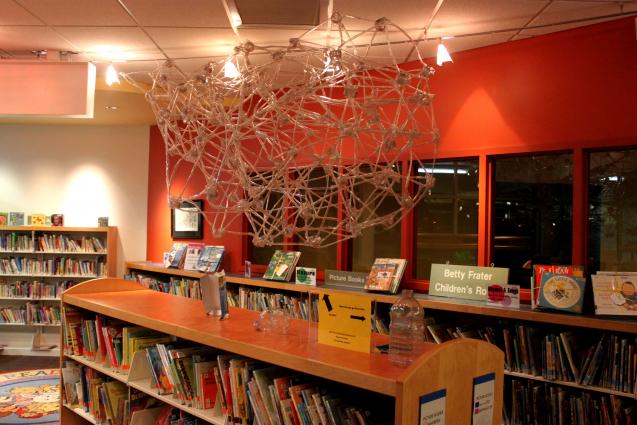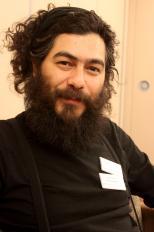






 A bottle sculpture in the Lakeview Library is an example of art made with repurposed materials. A new sculpture made of Tetra Paks is planned for the new Meadowridge branch (Esta Pratt-Kielley/Madison Commons).
A bottle sculpture in the Lakeview Library is an example of art made with repurposed materials. A new sculpture made of Tetra Paks is planned for the new Meadowridge branch (Esta Pratt-Kielley/Madison Commons).
A building block, an introduction, a prelude. Every great endeavor starts with something.
The beginning of an anticipated expansion is bringing together community, sustainability and new perspectives at the Meadowridge branch of the Madison Public Library system.
Kick-starting the Meadowridge Library expansion is a citywide collaboration: 2,403 Tetra Paks, a visionary artist and an engaged community. In other words, a social art project.
Meadowridge Library branch supervisor Alice Oakey said the expansion plan is in the “waiting period.”
“We know it’s going to happen, but we don’t see anything yet,” Oakey said. “In that waiting period, we have Victor creating the art, making the whole thing seem real; helping us wait.”
Although construction will not start for another four weeks, Oakey said as a community, “we’ve already begun.”
 Artist Victor Castro rejects the word 'recycled' when it comes to art materials (Esta Pratt-Kielly/Madison Commons).Victor Castro, 40, was hired to create a sculpture made entirely of Tetra Paks. Tetra Pak containers usually hold soup or rice milk and do not have to be refrigerated. They are made of paperboard, plastic and aluminum, but not easily recycled.
Artist Victor Castro rejects the word 'recycled' when it comes to art materials (Esta Pratt-Kielly/Madison Commons).Victor Castro, 40, was hired to create a sculpture made entirely of Tetra Paks. Tetra Pak containers usually hold soup or rice milk and do not have to be refrigerated. They are made of paperboard, plastic and aluminum, but not easily recycled.
Castro hopes to collect 2,403 Tetra Paks, which translates to 1 percent of Madison’s population. He has collected about 600 boxes in four months.
The art project itself could be looked at as the first step in the bigger project: the library expansion.
The current Meadowridge Library is a small space in the Meadowridge Shopping Center off Raymond Road.
A few things happened at once to make the upgrade a reality. An Ace Hardware store that occupied the space next door to the library moved out and Ald. Matt Phair thought that it was time to move the library into a larger space.
The neighboring Meadowridge Community Center will move into the old library space, and the space in between will be used as a collaborative space for the community center and library.
The $2.4 million project is funded by the city and through library fundraising.
To contribute to this expansion of the Meadowridge library, the Madison Arts Commission gave the library a $10,000 grant for an art project.
Castro is currently the artist-in-residence for the Bubbler Room at Central Library, a studio used to work on projects for the public.
“Victor is exuberant,” Oakey said. “He’s fearless. He makes you realize that anything is possible.”
Castro uses recyclable materials to create his sculptures. Although, he said he rejects the word ‘recycled.’
“For me, they are just art materials,” Castro said. “All homes need to have the trash bin, the recycle bin and the art materials bin.”
Castro seeks to transform everyday materials into something unique. He said he hopes his work can change the point of view of people so they are able to see these materials in a new way.
“It’s a kind of power to let people find their own ideas and think abstractly about these materials,” Castro said. “To think differently about the everyday can or milk box and wonder, ‘what can I do creatively with this?’”
 The slogan "Are you sure it's trash?" invites people to think about whether what they might throw away could be incorporated into art (Esta Pratt-Kielley/Madison Commons).
The slogan "Are you sure it's trash?" invites people to think about whether what they might throw away could be incorporated into art (Esta Pratt-Kielley/Madison Commons).
Castro calls this project a “social sculpture.” The piece is created more in the process of collaboration with the community rather than the final result. Nevertheless, he says he has no doubt that the sculpture will be “amazing and beautiful” because of the people and community involved.
“I think it will reflect very positively on the entire city,” Oakey said. “I think libraries reflect really well on a community, so the more we support the libraries, the stronger our community is.”
Oakey is excited by the huge impact the project has had on the community already.
“He’s not asking you to go buy something to contribute,” Oakey said. “Just something you have around the house.”
Castro has involved elementary schools around Madison, along with engaging all community members with workshops held at different branches.
Castro wants to empower young people by showing them that if they don’t agree with something in their life, they can do something to change it.
“These materials are like gold,” Castro said. “It is the present of the art. And I’m doing something bigger because I’m working with people, making them think and collaborating on a big project. In the end, it is the result of the will and hope of a huge community.”
The project developed a slogan, “Are you sure it’s trash?” to reinforce thinking twice before you throw something away.
“I don’t consider any of my materials ‘leftovers’,” Castro said, smiling and pulling out from his pocket a small glass tube with plastic bottle cap shavings inside. “If I have some physical matter, I can continue to make things. Like this, these are left over from another process that is left over from a different process. Now I have a pocket sculpture.”
Construction of the new space will start in early March and will hopefully be open sometime in the beginning of summer, according to Oakey.
Shortly after that, the sculpture will be put up outside of the library.
You can connect with the project through the Facebook and Twitter pages under the name “USgathering,” along with contributing your own Tetra Paks to the effort by dropping them off at any of the nine library branches.
“These materials are easy to work with because they are everywhere,” Castro said. “On the other hand, it’s difficult because you need to convince people to participate and change their preconceptions.”
|
|
|
Welcome to the Madison Commons, a website designed to provide news and information about all of Madison's neighborhoods and a crossroads for the discussion of community issues. The name comes from the idea of a village commons, a place for news, talk, debate, and some entertainment, too, that's open to everyone.
All rights reserved. Read more about the Madison Commons and its partners.

